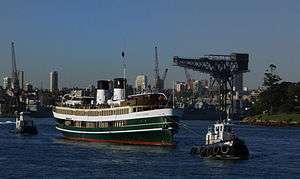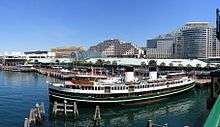SS South Steyne
 South Steyne being towed from Fleet Base East in June 2008 | |
| History | |
|---|---|
| Name: | SS South Steyne |
| Owner: | Port Jackson & Manly Steamship Company |
| Route: | Manly |
| Builder: |
|
| Cost: | ₤141,526[1] |
| Yard number: | 267[2] |
| Launched: | 1 April 1938 |
| In service: | 24 October 1938 |
| Out of service: | August 1974 |
| Identification: |
|
| General characteristics | |
| Type: | double-ended, double-screw steamship ferry |
| Tonnage: | 1,203 GT |
| Length: | 70 m (230 ft) |
| Beam: | 11 m (36 ft) |
| Installed power: | 3,250 IHP triple expansion steam engine |
SS South Steyne is a retired steam ferry. For 36 years, she operated on the Manly run on Sydney Harbour and is now moored at Dolphin Wharf of Old BP Site, Berry's Bay.
History


SS South Steyne was built by Henry Robb in Leith, Scotland for the Port Jackson & Manly Steamship Company. Launched on 1 April 1938, she set off on 7 July, to steam the 22,000 kilometres to Australia, where she arrived on 19 September.[4]
The South Steyne was brought to Australia by Captain RM Beedie, an English Master who returned home after the voyage. Also on the voyage was Captain AE Rowlings, who acted as first officer who went to England to take delivery of the vessel on behalf of the owner, and Captain C Henderson, the second officer, who was reported by the Sydney Morning Herald to be a native of Manly.[5]
In 1953 the South Steyne was chartered to run Sunday cruises from Sydney to Broken Bay. It was the first Manly ferry to run day trips to the Pittwater area since the ferries Bingarra and Burra Bra were flagships of the Pittwater regatta in 1922 and 1928. The Broken Bay cruises lasted until the early 1970s. On 29 September 1970 South Steyne collided with the HMAS Melbourne while avoiding some racing yachts. Nobody was hurt and South Steyne only received minor damage to the bow.
She was withdrawn from service as a commuter ferry in 1974 when the government took up the option to purchase only Baragoola and North Head. South Steyne used three times the fuel of the diesel-electric powered ferries. On 25 August 1974, a week after the last run, a fire was deliberately lit in the forced draft fan room where three open drums of diesel were placed to accelerate the fire. The ferry's sprinkler system was sabotaged with a large screwdriver thrust into the little fuel tank supplying the diesel fire pump so it couldn't start. The fire severely damaged the fan room, middle stairway and promenade deckhouse above.If it hadn't been for the quick response of the Balmain fire brigade, the ferry would have been completely destroyed.[4]
A group of concerned Manly residents formed a Preservation Society in 1975 that was called "Save Our Steyne". They were able to prevent the ferry from being towed behind an old aircraft carrier, and scrapped in Hong Kong. The major damage in the fan room was repaired, new light fittings added to the promenade deck, the funnels and promenade deck sand blasted and the whole ferry was repainted. Negotiations with the Public Transport Commission took place to allow the ferry to run two return, peak-hour services to Manly, Monday to Friday. However, running the ferry was very political and restoration of the boilers was hampered by the surveyors from the Maritime Services Board. Lloyds Register offered to hold the survey for the ferry but she was soon returned to the vendors because repayments were not made.
Restoration work began in 1987 at Rileys Hill Dry Dock near Ballina and later in Melbourne.[4] She became a floating restaurant, first in Melbourne and then in Newcastle. After five years, she returned to Sydney as the 2000 Olympic Information Centre at Darling Harbour. She is once again a floating restaurant, next to Pyrmont Bridge, offering panoramic waterfront views of the Sydney skyline. In April 2016 it was temporarily relocated to Berrys Bay while the Darling Harbour wharf was rebuilt.[6]
Layout
South Steyne is a double-ended, double-screw steamship constructed to ocean-going standards. The hull is riveted steel, with a bar keel, 8 watertight bulkheads and a double bottom under the engine only.[4] At 70 metres long she was the world's largest operational steam ferry.[7] The steel superstructure rises to sun deck level, with teak decks and wheelhouses. One of her two funnels is a dummy, containing a water tank.
She is powered by a 3,250 IHP 4 cylinder triple expansion steam engine, manufactured by Harland & Wolff of Belfast.
Service
South Steyne was the largest ferry to operate on Sydney Harbour. As a Manly ferry from 1938, she crossed between Circular Quay and Manly over 100,000 times over her 36 years, carrying well in excess of 92 million passengers. On Sundays, from 1953 until 1973, she gave short ocean cruises to Broken Bay.[7]
Coordinates: 33°52′13.44″S 151°11′57.48″E / 33.8704000°S 151.1993000°E
References
- ↑ Graeme Andrews (1994). Ferries of Sydney (3rd ed.). Sydney University Press.
- ↑ "Ship No 267". Leith Built Ships. Retrieved 27 June 2010.
- ↑ "South Steyne IMO: 5335151". Shipspotting. Retrieved 27 June 2010.
- 1 2 3 4 "South Steyne". Heritage Branch, NSW Department of Planning. Retrieved 21 July 2013.
- ↑ "New Ferry for Manly Run". Sydney Morning Herald. NSW: National Library of Australia. 10 September 1938. p. 12. Retrieved 10 September 2015.
- ↑ Home South Steyne
- 1 2 "Remember the South Steyne...". South Steyne. Retrieved 27 June 2010.
External links
![]() Media related to South Steyne (ship, 1938) at Wikimedia Commons
Media related to South Steyne (ship, 1938) at Wikimedia Commons